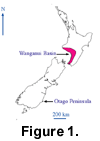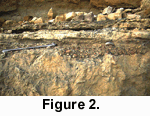STRATIGRAPHY AND ENVIRONMENT
The coloured brachiopods were collected from one
of the most recent of a remarkable series of marine terraces that provides
excellent exposure of the Quaternary sediments in the Wanganui Basin (Figure
1).  Running
for over 100 km parallel to the present-day coastline and extending over 20 km
inland at elevations of over 300 m, these terraces are interpreted as the
product of Quaternary sea-level fluctuations and tectonic uplift (Fleming
1953; Pillans 1990). In
essence, the terraces and their overlying coverbeds are inferred to have been
formed during relatively warm interglacial periods when rising sea-levels
produced marine transgressions that first cut a terrace in the existing Wanganui
sediments and then deposited richly fossiliferous marine sediments. Cold glacial
phases would have seen the retreat of the sea and a period of non-deposition.
Because of rapid tectonic uplift, these terraces have been protected from
subsequent destruction, and a series of 12 terraces has been identified dating
back to approximately 700,000 ka (Pillans
1990).
Running
for over 100 km parallel to the present-day coastline and extending over 20 km
inland at elevations of over 300 m, these terraces are interpreted as the
product of Quaternary sea-level fluctuations and tectonic uplift (Fleming
1953; Pillans 1990). In
essence, the terraces and their overlying coverbeds are inferred to have been
formed during relatively warm interglacial periods when rising sea-levels
produced marine transgressions that first cut a terrace in the existing Wanganui
sediments and then deposited richly fossiliferous marine sediments. Cold glacial
phases would have seen the retreat of the sea and a period of non-deposition.
Because of rapid tectonic uplift, these terraces have been protected from
subsequent destruction, and a series of 12 terraces has been identified dating
back to approximately 700,000 ka (Pillans
1990).
The brachiopods were collected from the basal
conglomerate that rests on the Hauriri Terrace (Figure
2).  The
terraces have been dated using a combination of techniques [fission-track
dating, radiocarbon dating, amino acid racemization, and a terrace-deformation
model - (Pillans 1990)], and the
age of the Hauriri Terrace is interpreted as approximately 80 ka. The basal
conglomerate would have been deposited pene-contemporaneously with the formation
of the terrace which is richly fossiliferous in places. The coloured brachiopods
were obtained from a coastal exposure, approximately 250 m east of the mouth of
the Wairoa Stream, 7 km from the town of Waverley, South Taranaki (Map Reference
N137/170992; Old Series 1inch Map). The fossils are present along a 35-m section
of vertical cliff, in a narrow, impersistent, pebbly and conglomeratic bed that
has a maximum thickness of approximately 0.2 m at this locality and is situated
about 2 m above the present beach level.
The
terraces have been dated using a combination of techniques [fission-track
dating, radiocarbon dating, amino acid racemization, and a terrace-deformation
model - (Pillans 1990)], and the
age of the Hauriri Terrace is interpreted as approximately 80 ka. The basal
conglomerate would have been deposited pene-contemporaneously with the formation
of the terrace which is richly fossiliferous in places. The coloured brachiopods
were obtained from a coastal exposure, approximately 250 m east of the mouth of
the Wairoa Stream, 7 km from the town of Waverley, South Taranaki (Map Reference
N137/170992; Old Series 1inch Map). The fossils are present along a 35-m section
of vertical cliff, in a narrow, impersistent, pebbly and conglomeratic bed that
has a maximum thickness of approximately 0.2 m at this locality and is situated
about 2 m above the present beach level.
The locality that yielded coloured brachiopods is
close to or at fossil locality G.S. 4174 of Wanganui Memoir of the Geological
Survey of New Zealand (Fleming 1953).
The coastal section in this area is predominantly composed of unconsolidated
sediments that are subject to rapid erosion, and it is possible that the
particular exposure yielding coloured fossils was not available to earlier
investigators, and the section will shortly be destroyed by erosion. Two species
of brachiopod are listed in the Wanganui Memoir as components of an extensive
fauna from this and other fossiliferous localities at the base of what was then
known as the Rapanui Formation (Fleming
1953). However the Wanganui Memoir makes no mention of the preservation of
original colouration at this locality, and the discovery of a single specimen of
the brachiopod Terebratella sanguinea during the present study is a new
addition to the faunal list from the basal conglomerate of the Rapanui
Formation. Subsequent work (Pillans
1990) has led to a subdivision of the Rapanui Formation, sensu Fleming
1953.
The fossils were deposited at or below low-tide
level off an open eroding coast, and many of the species present are
characteristic of present-day eroding coastlines in New Zealand (Fleming
1953). These species, including the brachiopods, are presumed to be
indigenous because they are largely intact or cleanly broken and show no signs
of abrasions or other damage consistent with significant transportation. A
subset of the species recorded are more characteristic of offshore silty and
sandy habitats, and these abraded and encrusted shells are thought to have been
transported into the area of deposition. A third discrete set of fossils is
apparent at this locality--massive oysters and other thick-shelled molluscs that
are believed to have been eroded from the gently-dipping fossiliferous Upper
Waipipi Shellbed that formed the substrate on which the terrace was formed and
the Hauriri sediments were deposited (Fleming
1953). The faunal list compiled by Fleming
(1953) includes over 150 different species, the great majority being
molluscs, from the several different localities then assigned to the Rapanui
Formation.

 Running
for over 100 km parallel to the present-day coastline and extending over 20 km
inland at elevations of over 300 m, these terraces are interpreted as the
product of Quaternary sea-level fluctuations and tectonic uplift (Fleming
1953; Pillans 1990). In
essence, the terraces and their overlying coverbeds are inferred to have been
formed during relatively warm interglacial periods when rising sea-levels
produced marine transgressions that first cut a terrace in the existing Wanganui
sediments and then deposited richly fossiliferous marine sediments. Cold glacial
phases would have seen the retreat of the sea and a period of non-deposition.
Because of rapid tectonic uplift, these terraces have been protected from
subsequent destruction, and a series of 12 terraces has been identified dating
back to approximately 700,000 ka (Pillans
1990).
Running
for over 100 km parallel to the present-day coastline and extending over 20 km
inland at elevations of over 300 m, these terraces are interpreted as the
product of Quaternary sea-level fluctuations and tectonic uplift (Fleming
1953; Pillans 1990). In
essence, the terraces and their overlying coverbeds are inferred to have been
formed during relatively warm interglacial periods when rising sea-levels
produced marine transgressions that first cut a terrace in the existing Wanganui
sediments and then deposited richly fossiliferous marine sediments. Cold glacial
phases would have seen the retreat of the sea and a period of non-deposition.
Because of rapid tectonic uplift, these terraces have been protected from
subsequent destruction, and a series of 12 terraces has been identified dating
back to approximately 700,000 ka (Pillans
1990).